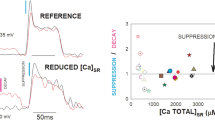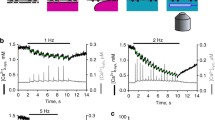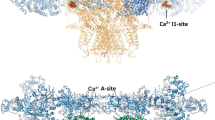Abstract
Single channel properties of cardiac and fast-twitch skeletal muscle sarcoplasmic reticulum (SR) release channels were compared in a planar bilayer by fusing SR membranes in a Cs+-conducting medium. We found that the pharmacology, Cs+ conductance and selectivity to monovalent and divalent cations of the two channels were similar. The cardiac SR channel exhibited multiple kinetic states. The open and closed lifetimes were not altered from a range of 10−7 to 10−3 M Ca2+, but the proportion of closed and open states shifted to shorter closings and openings, respectively.
However, while the single channel activity of the skeletal SR channel was activated and inactivated by micromolar and millimolar Ca2+, respectively, the cardiac SR channel remained activated in the presence of high [Ca2+]. In correlation to these studies, [3H]ryanodine binding by the receptors of the two channel receptors was inhibited by high [Ca2+] in skeletal but not in cardiac membranes in the presence of adenine nucleotides. There is, however, a minor inhibition of [3H]ryanodine binding of cardiac SR at millimolar Ca2+ in the absence of adenine nucleotides.
When Ca2+-induced Ca2+ release was examined from preloaded native SR vesicles, the release rates followed a normal biphasic curve, with Ca2+-induced inactivation at high [Ca2+] for both cardiac and skeletal SR. Our data suggest that the molecular basis of regulation of the SR Ca2+ release channel in cardiac and skeletal muscle is different, and that the cardiac SR channel isoform lacks a Ca2+-inactivated site.
Similar content being viewed by others
References
Ashley, R.H., Williams, A.J. 1990. Divalent cation activation and inhibition of single calcium channels from sheep cardiac sarcoplasmic reticulum. J. Gen. Physiol. 95:981–1005
Chamberlain, B.K., Volpe, P., Fleischer, S. 1984. Calcium-induced calcium release from purified cardiac sarcoplasmic reticulum vesicles. J. Biol. Chem. 259:7540–7546
Chu, A., Diaz-Munoz, M., Hawkes, M.J., Brush, K., Hamilton, S.L. 1990. Ryanodine as a probe for the functional state of the skeletal muscle sarcoplasmic reticulum calcium release channel. Mol. Pharm. 37:735–741
Chu, A., Dixon, M.C., Seiler, S., Saito, A., Fleischer, S. 1988. Isolation of longitudinal tubules and junctional terminal cisternae from rabbit skeletal muscle. Methods Enzymol. 157:36–46
Chu, A., Submilla, C., Scales, D., Piazza, A., Inesi, G. 1988. Trypsin digestion of junctional sarcoplasmic reticulum vesicles. Biochemistry 27:2827–2833
Colquhoun, D., Sigworth, F.J. 1983. Fitting and statistical analysis of single-channel records. In: Single-Channel Recording. B. Sakmann and E. Neher, editors. pp. 191–264. Plenum, New York
Cukierman, S., Yellen, G., Miller, C. 1985. The K+ channel of sarcoplasmic reticulum. A new look at Cs+ block. Biophys. J. 48:477–484
Decker, E.R., Dani, J.A. 1990. Calcium permeability of the nicotinic acetylcholine receptor: the single-channel calcium influx is significant. J. Neurosci. 10:3413–3420
Fabiato, A. 1985. Time and calcium dependence of activation and inactivation of calcium-induced release of calcium from the sarcoplasmic reticulum of a skinned canine cardiac Purkinje cell. J. Gen. Physiol. 85:247–289
Fabiato, A. 1988. Computer programs for calculating total from specified free or free from specified total ionic concentrations in aqueous solutions containing multiple metals and ligands. Methods Enzymol. 157:378–417
Fabiato, A. 1989. Appraisal of the physiological relevance of two hypotheses for the mechanism of calcium release from mammalian cardiac sarcoplasmic reticulum: calcium-induced release versus charge-coupled release. Mol. Cell. Biochem. 89:135–140
Fill, M., Coronado, R., Mickelson, J.R., Vilven, J., Ma, J., Jacobson, B.A., Louis, C.F. 1990. Abnormal ryanodine receptor channels in malignant hyperthermia. Biophys. J. 50:471–475
Fill, M., Mejias-Alvarez, R., Zorzato, F., Volpe, P., Stefani, E. 1991. Antibodies as probes for ligand gating of single sarcoplasmic reticulum Ca2+-release channels. Biochem. J. 273:449–457
Fill, M., Stefani, E., Nelson, T.E. 1991. Abnormal human sarcoplasmic reticulum Ca2+ release channels in malignant hyperthermic skeletal muscle. Biophys. J. 59:1085–1090
Hamilton, S.L., Mejias-Alvarez, R., Fill, M., Hawkes, M.J., Brush, K.P., Schilling, W.P., Stefani, E. 1989. [3H]PN200–110 and [3H]ryanodine binding and reconstitution of ion channel activity with skeletal muscle membranes. Anal. Biochem. 183:31–41
Lai, F.A., Meissner, G. 1989. The muscle ryanodine receptor and its intrinsic Ca2+ channel activity. J. Bioenerg. Biomembr. 21:227–246
Lindsay, A.R.G., Manning, S.D., Williams, A.J. 1991. Monovalent cation conductance in the ryanodine receptorchannel of sheep cardiac muscle sarcoplasmic reticulum. J. Physiol. 439:463–480
Ma, J., Fill, M., Knudson, M., Campbell, K.P., Coronado, R. 1988. Ryanodine receptor of skeletal muscle is a gap junction-type channel. Science 242:99–102
Michalak, M., Dupraz, P., Shoshan-Barmatz, V. 1988. Ryanodine binding to sarcoplasmic reticulum membrane; comparison between cardiac and skeletal muscle. Biochim. Biophys. Acta 939:587–594
Meissner, G. 1986. Ryanodine activation and inhibition of the Ca2+ release channel of sarcoplasmic reticulum. J. Biol. Chem. 261:6300–6306
Rousseau, E., Meissner, G. 1989. Single cardiac sarcoplasmic reticulum Ca2+-release channel: activation by caffeine. Am. J. Physiol. 256:H328-H333
Meissner, G., Darling, E., Eveleth, J. 1986. Kinetics of rapid Ca2+ release by sarcoplasmic reticulum. Effects of Ca2+, Mg2+, and adenine nucleotides. Biochemistry 25:236–244
Meissner, G., Henderson, J.S. 1987. Rapid calcium release from cardiac sarcoplasmic reticulum vesicles is dependent on Ca2+ and is modulated by Mg2+, adenine nucleotide, and calmodulin. J. Biol. Chem. 262:3065–3073
Meves, H., Vogel, W. 1973. Calcium inward currents in internally perfused giant axons. J. Physiol. 235:225–265
Nelson, T.E., Lin, M., Volpe, P. 1991. Evidence for intraluminal Ca++ regulatory site defect in sarcoplasmic reticulum from malignant hyperthermia pig muscle. J. Pharmacol. Exp. Ther. 256:645–649
Nelson, T.E., Nelson, K. 1990. Intra- and extraluminal sarcoplasmic reticulum membrane regulatory sites for Ca2+-induced Ca2+ release. FEBS Lett. 263:292–294
Ogawa, Y., Harafuji, H. 1990. Osmolarity-dependent characteristics of [3H]ryanodine binding to sarcoplasmic reticulum. J. Biochem. (Tokyo) 107:894–898
Otsu, K., Willard, H.F., Khanna, V.K., Zorzato, F., Green, N.M., MacLennan, D.H. 1990. Molecular cloning of cDNA encoding the Ca2+ release channel (ryanodine receptor) of rabbit cardiac muscle sarcoplasmic reticulum. J. Biol. Chem. 265:13472–13483
Pessah, I.N., Waterhouse, A.L., Casida, J.E. 1985. The calcium-ryanodine receptor complex of skeletal and cardiac muscle. Biochem. Biophys. Res. Commun. 128:449–456
Rousseau, E., Smith, J.S., Henderson, J.S., Meissner, G. 1986. Single channel and 45Ca2+ flux measurements of the cardiac sarcoplasmic reticulum calcium channel. Biophys. J. 50:1009–1014
Rousseau, E., Smith, J.S., Meissner, G. 1987. Ryanodine modifies conductance and gating behavior of single Ca2+ release channel. Am. J. Physiol. 253:C364-C368
Sitsapesan, R., Williams, A.J. 1990. Mechanisms of caffeine activation of single calcium-release channels of sheep cardiac sarcoplasmic reticulum. J. Physiol. 423:425–439
Smith J.S., Coronado, R., Meissner, G. 1986. Single channel measurements of the calcium release channel from skeletal muscle sarcoplasmic reticulum. J. Gen. Physiol. 88:573–588
Smith, J.S., Imagawa, T., Ma, J., Fill, M., Campbell, K.P., Coronado, R. 1988. Purified ryanodine receptor from rabbit skeletal muscle is the calcium-release channel of sarcoplasmic reticulum. J. Gen. Physiol. 92:1–26
Smith, J.S., Rousseau, E., Meissner, G. 1989. Calmodulin modulation of single sarcoplasmic reticulum Ca2+-release channels from cardiac and skeletal muscle. Circ. Res. 64:352–359
Tate, C.A., Bick, R.J., Chu, A., Van Winkle, W.B., Entman, M.L. 1985. Nucleotide specificity of cardiac sarcoplasmic reticulum. GTP-induced calcium accumulation and GTPase activity. J. Biol. Chem. 260:9618–9623
Williams, A.J., Holmberg, S.R.M. 1990. Sulmazole (AR-L 115BS) activates the sheep cardiac muscle sarcoplasmic reticulum calcium-release channel in the presence and absence of calcium. J. Membrane Biol. 115:167–178
Williams, A.J. 1992. Ion conduction and discrimination in the sarcoplasmic reticulum ryanodine receptor/calcium-release channel. J. Muscle Res. Cell Motil. 13:7–26
Williams, A.J., Ashley, R.H. 1989. Reconstitution of cardiac sarcoplasmic reticulum calcium channels. Ann. NY Acad. Sci. 560:163–173
Zimanyi, I., Pessah, I.N. 1991. Comparison of [3H]ryanodine receptors and Ca++ release from rat cardiac and rabbit skeletal muscle sarcoplasmic reticulum. J. Pharmacol. Exp. Ther. 256:938–946
Author information
Authors and Affiliations
Additional information
This work was supported by research grants from the National Institutes of Health HL13870 and AR38970, and the Texas Affiliate of the American Heart Association, 91A-188. M. Fill was the recipient of an NIH fellowship AR01834.
Rights and permissions
About this article
Cite this article
Chu, A., Fill, M., Stefani, E. et al. Cytoplasmic Ca2+ does not inhibit the cardiac muscle sarcoplasmic reticulum ryanodine receptor Ca2+ channel, although Ca2+-induced Ca2+ inactivation of Ca2+ release is observed in native vesicles. J. Membarin Biol. 135, 49–59 (1993). https://doi.org/10.1007/BF00234651
Received:
Revised:
Issue Date:
DOI: https://doi.org/10.1007/BF00234651




